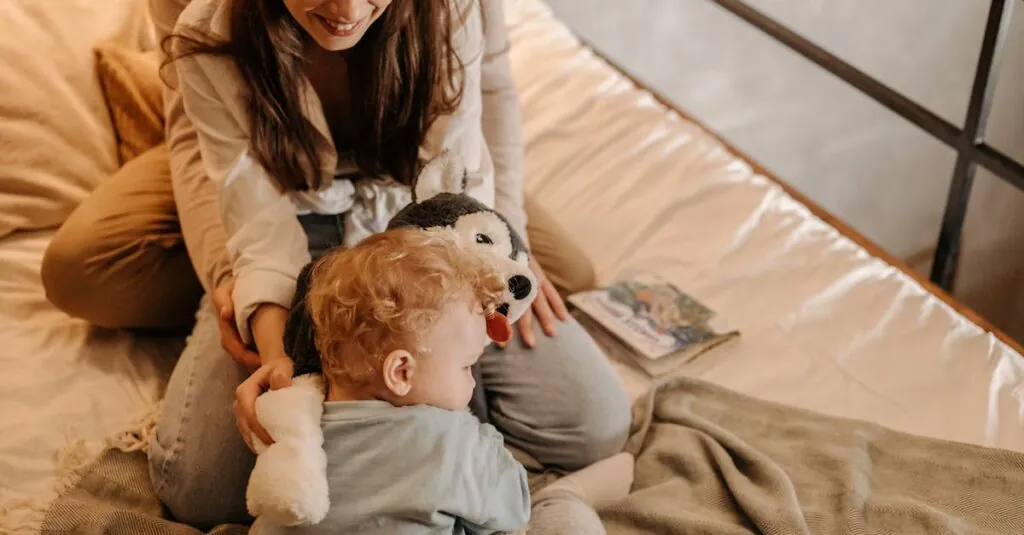Table of Contents
ToggleWhen it comes to bedtime, every parent knows the struggle of getting their little ones to settle down. Enter the preschooler bed—a magical realm where dreams come true and tantrums turn into snores. These beds aren’t just furniture; they’re the secret weapon in the battle for a peaceful night’s sleep.
Overview of Preschooler Beds
Preschooler beds serve as essential components in creating a conducive sleep environment. These beds cater specifically to the needs of young children, ensuring comfort and safety during sleep.
Importance of Choosing the Right Bed
Selecting the appropriate bed significantly influences a preschooler’s sleep quality. A bed that offers the correct size supports growth and development, reducing the risk of falls as toddlers transition from cribs. Safety features, such as guardrails, provide additional security, allowing parents to feel confident. Comfort contributes not only to achieving restful sleep but also to fostering positive bedtime routines. Ultimately, choosing the right bed creates a supportive atmosphere for preschoolers and promotes healthier sleep patterns.
Different Types of Preschooler Beds
Options for preschooler beds vary widely, catering to diverse preferences and needs. Twin beds provide ample space for growth, appealing to many parents seeking long-term solutions. Toddler beds, designed for smaller frames, help ease the shift from cribs, fostering independence. Lofted beds maximize room space, offering play areas underneath while ensuring accessibility. Bunk beds present solutions for shared rooms, adding fun to sleep arrangements. Each type serves distinct functions, addressing differing space requirements and individual child preferences effectively.
Features to Consider
Selecting the right preschooler bed involves evaluating several key features. A focus on size, safety, and design helps create a suitable sleeping environment.
Size and Dimensions
Size plays a critical role in choosing a preschooler bed. Ensure the bed fits comfortably within the child’s room while leaving space for play. Standard toddler beds typically measure 28 inches by 52 inches, while twin beds are larger at 38 inches by 75 inches. A proper fit promotes ease of movement and reduces the risk of accidents. Consider the child’s growth; opting for a convertible bed can extend usability as they grow.
Safety Features
Safety features are essential when selecting a preschooler bed. Look for beds with guardrails, as these prevent falls during sleep. A sturdy frame made of high-quality materials enhances stability and security. Additionally, non-toxic finishes on wooden beds ensure safety against harmful chemicals. Check for a weight capacity that accommodates the child’s size, providing extra reassurance during use. Prioritizing these features minimizes safety risks and fosters worry-free sleep.
Design and Style
Design and style significantly impact a child’s willingness to sleep in their new bed. Bright colors and fun themes energize the room and make bedtime appealing. Beds shaped like cars or princess castles often excite preschoolers, encouraging them to embrace sleep. Simplicity in design allows for easy integration with existing decor. Opt for styles that provide clear pathways for getting in and out, promoting independence. A well-chosen design balances aesthetics and functionality, creating a positive sleep environment.
Popular Preschooler Bed Options
Several popular bed options exist for preschoolers, catering to their specific needs and preferences. Each type supports comfort and safety, helping children develop healthy sleep habits.
Wooden Beds
Wooden beds offer durability and timeless appeal. Many parents prefer solid wood frames due to their sturdiness, which accommodates playful preschoolers. These beds come in various styles, including classic and modern designs. Customization options allow for unique finishes that blend with room decor. Ease of maintenance is a significant benefit, as wooden surfaces simply require basic cleaning.
Loft Beds
Loft beds maximize space in small rooms, giving children room to play underneath. Parents appreciate their versatility, as some models include built-in storage or desks below. Safety features like guardrails ensure children stay secure while sleeping. Designs often feature playful themes, inspiring imagination. By elevating the sleeping area, loft beds open up creative possibilities for play and organization.
Convertible Beds
Convertible beds adapt as children grow, transitioning from a toddler bed to a twin bed. This flexibility appeals to parents looking for long-term solutions. Designs typically include removable side rails for added safety during toddler years. Later, the bed can expand to accommodate their child’s changing needs. Many convertible options emphasize style, seamlessly fitting into various bedroom aesthetics.
Tips for Transitioning to a Preschooler Bed
Transitioning to a preschooler bed can be smooth with the right approach. Parents can ensure their child feels supported and excited about this change.
Preparing Your Child
Engage the child in discussions about their new bed. Encouraging them to express their thoughts fosters a sense of ownership. Involve them in choosing bedding and accessories that resonate with their interests. Explain the benefits of moving to a big kid bed and frame it as an adventure. Setting a consistent bedtime routine helps establish expectations. This routine can include reading a story or cuddling to create a calming atmosphere before sleep.
Creating a Comfortable Sleep Environment
A comfortable sleep environment plays a crucial role in effective sleep transitions. Consider soft bedding and familiar blankets that the child loves. Incorporate dim lighting and soothing colors to create a relaxing ambiance. Offering a bedtime toy or security object can provide additional comfort. Ensure the room is cool and quiet, minimizing distractions that may disrupt sleep. Using a nightlight can help ease nighttime fears, promoting a more peaceful rest experience.
Choosing the right preschooler bed is essential for fostering healthy sleep habits. It not only enhances comfort and safety but also plays a significant role in establishing a positive bedtime routine. By considering factors like design, size, and safety features, parents can create an inviting sleep environment that encourages their children to embrace bedtime.
Transitioning to a preschooler bed can be a smooth process with the right approach. Engaging children in the selection process and maintaining a consistent bedtime routine can make all the difference. Ultimately, investing in a quality preschooler bed supports better sleep for both preschoolers and their parents, paving the way for a restful night and a brighter day ahead.







